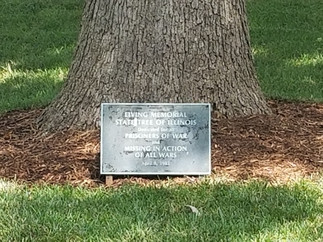The Governor of Illinois Welcomes You!
- Carl B. Forkner, Ph.D.
- Jul 1, 2021
- 3 min read

July 2018. Illinois’ governors have called Springfield home since 1839, when the capital was moved from Vandalia to Springfield, and the General Assembly passed legislation requiring the governor to “reside at the seat of Government” during his term. The state provided the governor with housing, originally housing the first family in a state-owned building that also housed the Board of Public Works.
In 1855, newly elected Governor Joel A. Matteson asked the legislature to build a new executive residence large enough to host his family and state events. The General Assembly granted the governor’s request, appropriating $18,000 and hiring architect John M. Van Osdel, who had also designed Chicago’s City Hall and the Cook County Courthouse. Van Osdel designed the mansion to complement the Greco-Roman style of other government buildings. Despite the European influence, the mansion was distinctly Springfield due to the use of locally-sourced red pressed brick for the exterior. Governor Matteson became the first governor to live in the home on January 10, 1856. In 1871, Governor Oglesby signed legislation that made use of the mansion part of the governor’s compensation during his term.
The Executive Mansion became the center of the Springfield social scene, hosting weddings and holiday parties, and a variety of key figures in American history and culture including President Ulysses S. Grant, President Rutherford B. Hayes, General William Sherman, President Lincoln’s son Robert, President William McKinley, President Herbert Hoover, President Franklin Delano Roosevelt, “Buffalo Bill” Cody and Annie Oakley. Shortly before his nomination as the Republican candidate for President in 1860, Abraham Lincoln came to the Mansion to visit and offer comfort to Governor William H. Bissell, who was on his deathbed.
While the General Assembly appropriated funds for repairs, refurbishments and maintenance approximately every two years, by 1889 the building needed substantial updates. Governor Joseph Fifer approved a lump sum of $13,500 and Springfield architect George Helmle oversaw the remodel of the Executive Mansion in the popular Victorian style, which included painting the exterior red brick a “light stone color” in an effort to emulate the White House. Helmle was brought back to remodel the mansion in 1897, this time adding a portico to the front entrance and enclosing the cupola at the Mansion’s peak. The next major renovation was completed in 1917, transitioning the Mansion from the Victorian style to an Italianate style. In a break from previous practice, Governor Lowden and his wife split the $50,000 cost with the State.
Efforts to maintain the mansion struggled to keep up with time and weather. In 1961 a fire in New York State’s executive residence launched intense scrutiny of the condition of Illinois’ Executive Mansion. It was found to be severely lacking; the roof leaked and many of the floors were in danger of collapsing, leading the Chicago Sun-Times to call the mansion “a hazard, as well as a horror.”
In response to public criticism, in 1961 the Illinois House of Representatives introduced a bill to build a new Executive Residence. Preservationists across the state, including some former governors and first ladies, strongly objected, advocating for the restoration and protection of the mansion as an historic site. The funds for such a restoration, however, were not readily available. Governor Kerner vetoed a 1965 bill appropriating $900,000 for Mansion repairs due to a lack of funds.
In response to continued debate over whether the Mansion should be renovated or rebuilt entirely, Governor Ogilvie created the Illinois Executive Mansion Commission to study the feasibility and cost of renovations. The commission’s recommended renovations included expanding the east and west wings to house administrative offices. Governor Ogilvie and his wife, Dorothy, opposed this plan, arguing that it would ruin the historical appearance of the building. Instead, the Ogilvies charged James T. Hickey and Lowell Anderson of the Illinois State Historical Library with overseeing a $3 million effort to restore the mansion to focus on features from the original 1855 construction. The renovations, starting in 1971, included an addition to the south half of the mansion, to create private living quarters for the Governor, while preserving as much of the original floor plan as possible. The Ogilvies’s efforts to preserve and protect the mansion came to fruition in 1976 when the Mansion was added to the National Register of Historic Places.
The renovation focused not only on restoring the mansion’s architecture, but also its interiors by redecorating the mansion with antique period pieces. In order to minimize the cost to taxpayers, the non-profit Illinois Executive Mansion Association was created to maintain and furnish the mansion using privately raised funds. Since the association’s creation, Illinois’ First Lady has served as honorary chairwoman, spearheading fundraising efforts.
Timeline of events related to Governor’s residence according to State of Illinois records.
















Comments